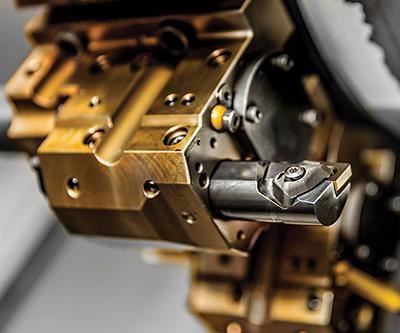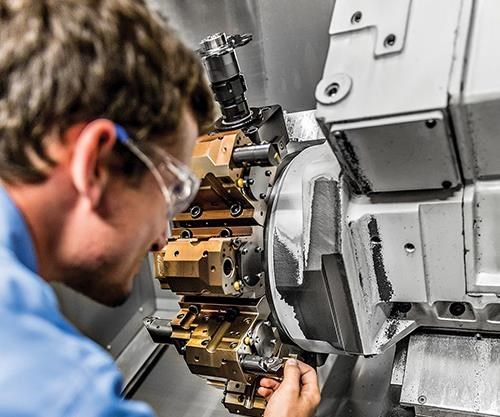Technology Investments Help Young Company Start Strong
Wolfram Manufacturing Inc. was experiencing poor tool life and inconsistent performance when machining gray cast iron. By changing its tooling to CVD-coated GC3205 turning inserts from Sandvik Coromant Co., the company could run the job lights-out.
Aside from hiring good people, successful companies embrace new technology, says Nathan Byman, president of Wolfram Manufacturing Inc. The Austin, Texas-based shop’s extensive equipment list would be impressive for any company, let alone one that is only five years old. Yet equipment alone wasn’t enough to efficiently machine parts made from super-tough materials. Finding the right tooling technology from Sandvik Coromant Co. (Fair Lawn, New Jersey) helped the company run a challenging application lights-out.
Wolfram has invested heavily in its technology. Its flagship is an Okuma Multus B400W multitasking machine with a 10,000-rpm, Coromant Capto-equipped spindle, 40-tool magazine, MP Systems 1,000-psi high-pressure coolant pump, inline machine probing and Caron Engineering adaptive feed system. A pair of similarly equipped Y-axis Okuma LB3000 EX MYW turn-mill centers sit a few feet away, together with robotic part handling and integrated inspection via a Renishaw Equator comparative gage.
Mr. Byman was the driver behind these acquisitions. Before starting with Wolfram, he worked for some large companies in the Houston area. He decided there was room for improvement in the way these companies served their customers and the rate at which they adopted new technology. According to Mr. Byman, when shops combine state-of-the-art machine tools, tooling and software technology to support it, they start to realize some pretty radical gains.
That’s exactly what Wolfram did with just 6,000 square feet and 14 employees. The company operates around the clock, specializing in high-mix, low-volume machining of complex parts, something Mr. Byman refers to as “strangers, runners and repeaters.” Volumes range from five to 10 parts to several thousand. Instead of taking on a bunch of prototype work that the company is never going to see again, he says the shop is optimized to invest in the process of machining complex parts and develop long-term relationships with its customers and suppliers.
Many of the complex parts the company machines are made of duplex steels, Inconel 718, Notronic 50 and other high-nickel alloys, with a typical part size somewhere between that of “a salt shaker and a fire hydrant.” Despite the machining challenges that come from these super-tough materials, Wolfram does much of its work unattended or lightly attended. This is possible because it focuses on continuous improvement and lean-manufacturing concepts, which Mr. Byman says eliminates many of the steps in traditional multi-step machining and ultimately delivers greater value to its customers.
However, pushing the envelope of traditional machining has its challenges. Recently, Wolfram accepted an order for a part known in the oil and gas industry as a “slip,” a workpiece General Manager Jeff Davis describes as a 4-inch-diameter ring with teeth and slots. “The slip is made from Dura-Bar, a gray cast iron. It’s fairly nasty stuff to machine. Eight pounds of raw casting goes into the machine, and 2 pounds of finished part comes out,” he says.
According to Mr. Davis, the slip’s part tolerances aren’t too bad—around ±0.002 inch is the tightest—but tool life was a real bear at first. The cycle time was just over 15 minutes. The turning tools were getting five or six parts per corner, and the end mills were not doing much better. The company tried different brands of carbide and increased the number to 24 parts per corner, which he says he was fairly happy with. However, tool life was still unpredictable.
After originally cutting the part on its Multus machining center, the company decided to take advantage of the automated handling and inspection systems on its Okuma lathes so it could run lights-out. Despite switching the part over to one of the smaller turn-mill machines, tool life was still an issue, however. Unhappy with the constant babysitting, Mr. Davis called the local Sandvik Coromant representative, Territory Productivity Engineer Chris Urban.
To get the process under control, Mr. Urban started with the milling cutters. Working with the Wolfram team, he designed a custom cutting tool to machine the small slots on the workpiece. Where a three-flute tool was used previously, Mr. Urban suggested using a CoroMill 327 six-flute tool, which effectively doubled the feed rate. He then swapped out the existing 80-degree AlTiN-coated turning insert for a GC3205 trigon-shaped insert with chemical vapor deposition (CVD) coating. Not only did this provide two additional cutting edges for a very small cost delta (around $2), but the insert’s CVD coating and tough carbide substrate also increased tool life to a reliable 50 pieces per edge, he says.
According to Mr. Davis, the switch also provided an interesting, yet unexpected benefit due to the coating color. The previous inserts featured a black coating that made it difficult for Wolfram employees to tell if the edges were worn. Sometimes they pushed the insert longer than they should have, and when it failed, the results were pretty dramatic, he says. On the other hand, the gold color of the coated CVD inserts from Sandvik Coromant make it clear how much wear there is, he says. Not only has the company doubled tool life, but the cycle time has been cut in half as well, from 15 minutes to just more than seven. The new process is stable enough that the parts can now be run in an automated fashion.
Mr. Byman attributes much of the company’s success to its overall embrace of technology. The adaptive feed capabilities of the Caron Engineering Tool Monitor Adaptive Control (TMAC) system, for example, optimize tool life and throughput by automatically modifying the feed rate based on cutting load and tool wear. Coupled with the feedback from the Equator gage, the machine can make its own offsets, freeing operators to do other work or even stay home.
“It’s been a valuable piece of the puzzle,” he says. “In a lot of ways, machining today is in the dark ages. There’s so much hit and miss. Shops take their best guess on feed rate or spindle speed, then it’s a matter of testing and more testing. The Caron Engineering system gives the machine the ability to react. You can get a stable process much more quickly.”
Looking back, Mr. Byman says there’s little he would change about the company’s initial approach. “We had a specific vision starting out. We knew there was an open niche for something we like to call ‘video-game machining,’ the premise being that you can launch a complicated part almost directly to the machine and be in production quickly, at a very efficient rate. Most of the country is still struggling to get there, primarily because shops have a hard time wrapping their arms around the technology needed to accomplish it. But when you start out that way, you realize the gains immediately, and you know that you would never want to go back to the old way of machining.”
Related Content
Toolpath Improves Chip Management for Swiss-Type Lathes
This simple change to a Swiss-type turning machine’s toolpath can dramatically improve its ability to manage chips.
Read MoreTwin Spindle Design Doubles Production of Small Parts
After experiencing process stalls in the finishing stage of production, Bryan Machine Service designed an air-powered twin spindle and indexable rotating base to effectively double its production of small parts.
Read MoreHow to Tackle Tough Angled Pocket Milling With Two Tools
Milling a deep pocket with a tight corner radius comes with unique challenges, but using both a flat bottom drill and a necked-down finishing tool can help.
Read MoreA New Milling 101: Milling Forces and Formulas
The forces involved in the milling process can be quantified, thus allowing mathematical tools to predict and control these forces. Formulas for calculating these forces accurately make it possible to optimize the quality of milling operations.
Read MoreRead Next
The Cut Scene: The Finer Details of Large-Format Machining
Small details and features can have an outsized impact on large parts, such as Barbco’s collapsible utility drill head.
Read More3 Mistakes That Cause CNC Programs to Fail
Despite enhancements to manufacturing technology, there are still issues today that can cause programs to fail. These failures can cause lost time, scrapped parts, damaged machines and even injured operators.
Read More













.png;maxWidth=300;quality=90)








.png;maxWidth=300;quality=90)












